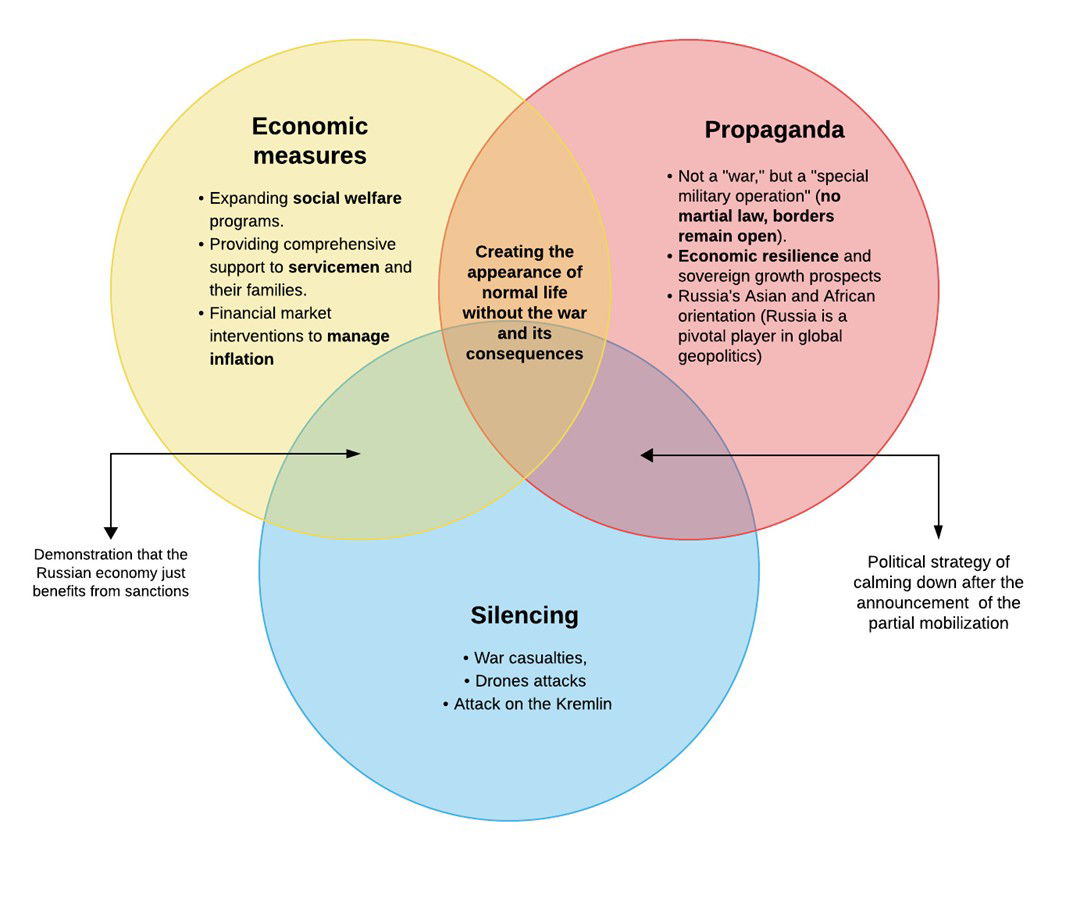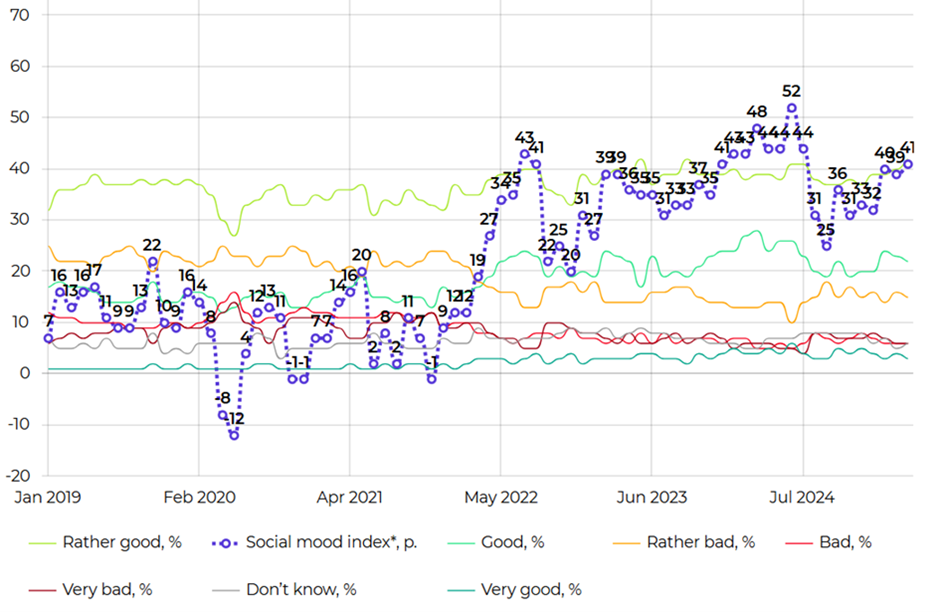Emotional Governance in Wartime Russia: Pacification, Fear and the Manipulation of Hope
by Olga Vlasova, Visiting Researcher, King's College London
Over the course of the Russian war in Ukraine, the Kremlin’s propaganda strategies have evolved through several shifts, sometimes appearing as inconsistencies in the Kremlin’s objectives. This article examines Russian propaganda through the lens of emotional governance - a form of power that aims to influence public feeling to sustain political control. This article focuses on how the Russian government has employed it to suppress dissent, shape public sentiment, and maintain regime stability. Analysing the various emotional governance strategies used by the Kremlin from February 2022 to May 2025 provides insight into the government’s real approach towards the Russian people: distancing society from the war rather than mobilising it, even though the latter may seem more natural for a country at war.
For over 20 years, the Kremlin has used strategies of depoliticisation to keep society disconnected from political involvement. However, the war in Ukraine, whether intentionally or not, has become a prolonged conflict that raises many political and geopolitical questions. Being inherently political, a war has the potential to generate interest and participation within society. Its scale, duration, and consequences influence many aspects of daily life and may prompt political interest not only among elites or those already involved in political debates but also among traditionally disengaged citizens who might start to question the state’s actions or strategic aims.
The Kremlin found itself in a situation where it needed to keep the majority's depoliticised stance while also managing the feelings of elites, regime supporters, and war opponents. In response, it has used different emotional governance strategies aimed at shaping the public mood in ways that serve the state’s interests. These strategies have combined pacification, fear, and false hope to suppress resistance and preserve control, albeit unevenly across groups and periods.
This blog traces the development of these emotional governance strategies over time, progressing through phases of pacification (2022–2024), fear (2022–2025), and hope (2025). However, these are not distinct stages but rather overlapping and coexisting strategies, each taking centre stage depending on the changing political and military context as well as the target audience.
Politics of pacification
During the first two years of the war, the politics of pacification was the primary approach used on the majority of the depoliticised segment of the Russian population. In the Russian context, the concept of politics of pacification refers to an emotional governance strategy implemented after the full-scale invasion, in which the Kremlin aimed to maintain societal passivity and emotional detachment from the war among the previously depoliticised sector of society. Diverging from the traditional politics of fear, depoliticization or demobilisation observed during peacetime, this approach emphasises a distinct form of governance that seeks to induce a state of societal inaction during wartime.
The concrete measures of the politics of pacification in Russia can be divided into three main areas (Figure 1):
1. Propaganda efforts:
- Specific media strategies for covering the war.
Russian state media often frame the conflict in Ukraine in a way that shifts focus away from its immediate effects. When the word "war" is mentioned, it often refers to conflicts elsewhere, reinforcing the official narrative that the situation in Ukraine is just a Special Military Operation (SMO) rather than a national crisis impacting all citizens.
Approximately 30% of news coverage related to the SMO concentrates on reassuring the population that daily life remains mostly unaffected. These reports emphasise the absence of martial law, the ongoing openness of borders, and the general stability of the domestic situation.
- Political messaging aimed at soothing public sentiment after the announcement of partial mobilisation, especially by emphasising its limited scope.
- Narratives portraying the Russian economy as benefiting from sanctions.
- Media content emphasising suffering in Western countries.
- Messaging that portrays Russia as a respected global actor, especially in Asia and Africa. Such coverage helps to build the perception of Russia as a key player in shaping regional dynamics and strengthening diplomatic connections.
2. Economic measures:
- Expansion of social welfare payments to vulnerable groups.
- Increases in pensions and state benefits, particularly for veterans and families of military personnel.
- Government interventions in markets to manage inflation and stabilise the rouble.
3. Silencing:
- The true number of war casualties.
- Coverage of drone attacks on Russian territory.
- Incidents such as the attack on the Kremlin.
- Other forms of distressing or potentially destabilising information.
All of these measures intend to give the depoliticised society a sense of normality during the war and to keep this segment of the population pacified even amid the conflict.

Figure 1: Politics of Pacification in Russia
The politics of pacification was relatively successful for the Kremlin during the first two years of the war, effectively keeping the depoliticised segment of society detached from the conflict. However, this strategy of emotional governance eventually proved inadequate in containing the rising levels of societal anxiety. According to WCIOM social mood indices, the situation began to shift after a wave of mass Ukrainian drone attacks on Moscow and the authorisation for Ukraine to use long-range weapons for strikes deep into Russian territory (Figure 2). For this reason, the Kremlin needed to introduce a new strategy of emotional governance, and in 2025, the politics of pacification was temporarily replaced by the manipulation of hope.

Figure 2: Social mood indices: situation in Russia. Question: How would you assess the situation in Russia, in general?
Politics of fear
Another widely used emotional governance strategy employed by the Kremlin towards specific segments of society is the politics of fear. Although it has long been part of the Kremlin’s toolkit, since February 2022, the politics of fear has notably intensified and grown in scope, becoming a key instrument for deterring dissent, disciplining elites, and sustaining power.
The politics of fear differs from the pacification strategy, which broadly aims to depoliticise and calm the population by encouraging disengagement and resignation rather than active resistance. While the politics of fear can also seek to maintain passivity, it employs different tools and strategic approaches.
For example, in the case of opposition and dissidents, the politics of fear has included: the repression of activists and opposition figures through criminal charges, detentions, and surveillance; media discourses that demonise opponents as traitors, foreign agents or terrorists; psychological tactics that foster self-censorship, paranoia and social mistrust.
For elites, fear manifested through coercion and co-optation. As illustrated by the Wagner rebellion and the fate of Yevgeny Prigozhin, stepping out of line carries existential risks. Even supporters are not immune: fear is subtly sustained through narratives of existential threats from the West, societal collapse without victory, and even nuclear war.
For the wider public, various new laws restricting internet usage and access to information have recently been introduced. For example, the intentional search for "extremist" materials online, even when accessed via VPNs has been criminalised, carrying fines of 3,000–5,000 roubles (≈$35–65). Advertising or promoting VPN services will also be severely penalised: individual fines of 50,000–80,000 roubles (≈$580–930), fines for officials of 80,000–150,000 roubles (≈$930-1,750), and up to 500,000 roubles (≈$5,830) for legal entities.
These laws are broad and ambiguously worded, leading to multiple interpretations, which further fuels fear among the population.
The politics of fear is an emotional governance strategy aimed at citizens who are engaged with politics or might show even a basic interest in political matters. If an individual begins to consider political engagement or independent judgement, they are likely to face various fear-inducing mechanisms, from legal threats to social and psychological pressures. Conversely, those who remain politically disengaged experience a sense of normalcy and stability, supported by the mechanisms of the pacification strategy. Together, these methods effectively depoliticise society and keep it aloof from politics, even amidst ongoing war.
Manipulation of Hope
To address the increasing levels of anxiety in Russian society, a new emotional governance strategy, which we have called manipulation of hope, was introduced at the start of 2025. This shift was prompted by external events such as Donald Trump’s electoral victory, his phone call with Vladimir Putin, and the commencement of negotiations between the United States and Russia in Riyadh.
Russian propaganda swiftly redefined its narratives. The West, particularly the United States, has now been portrayed as willing to compromise. Europe has been sidelined and depicted as insignificant in the negotiations. Russia has been shown as strong, victorious, and in control of the diplomatic agenda. For example, RIA Novosti (15 May, 2025) published headlines such as “Rubio expressed hope for swift progress in the peace process on Ukraine”, while TASS (15 February, 2025) highlighted statements suggesting that “Kellogg effectively confirmed that the U.S. does not see the EU as part of the Ukraine negotiations”.
Meanwhile, the main focus was on domestic issues expected to improve soon, such as the lifting of sanctions, the restoration of severed diplomatic ties with the West, the return of Western brands and bank cards, renewed confidence in Russia’s global influence, and the declining role of Europe.
Crucially, this new strategy has not involved any real concessions or peace plans. The military discourse remains unchanged, and no de-escalation has taken place on the battlefield. Instead, hope has been used as an emotional anaesthetic — not to signal peace, but to extend public patience and delay disillusionment at a time when the politics of pacification are no longer effective and societal anxiety is rising. The politics of hope has worked relatively well to keep society stable and longing for imminent relief or a return to normalcy.
However, Trump's support and effort remains quite inconsistent. If there are no clear signals from him that form the basis for hopeful messaging, and he chooses to abandon his peaceful efforts, will the Kremlin look for other sources of hope, or what kind of emotional strategy will Russian propaganda adopt next?
In sum, these are the main emotional governance strategies that we could identify by observing the Russian government-sponsored narratives during the war in Ukraine. The Kremlin’s reliance on emotional governance through mechanisms of fear, pacification, and hope reveals not only the workings of an authoritarian regime but also a deeper paradox: a wartime government that deliberately avoids engaging its own society. Rather than fostering mobilisation, the Russian state has focused on keeping the population passive, fragmented, and emotionally contained. At the same time, certain forms of targeted societal mobilisation, such as campaigns to recruit contract soldiers or to encourage higher birth rates, do occur, though they operate alongside rather than in place of the broader strategies of pacification, fear, and hope.
This raises important questions about the sincerity of public support for the war in Russia. It also encourages reflection on whether wider societal engagement in the conflict could disturb this delicate emotional balance and ultimately threaten regime stability.